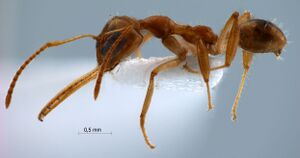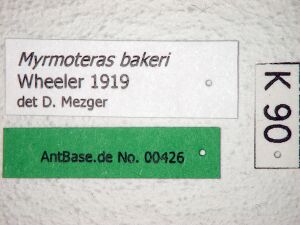Myrmoteras bakeri
| Myrmoteras bakeri | |
|---|---|

| |
| Scientific classification | |
| Kingdom: | Animalia |
| Phylum: | Arthropoda |
| Class: | Insecta |
| Order: | Hymenoptera |
| Family: | Formicidae |
| Subfamily: | Formicinae |
| Tribe: | Myrmoteratini |
| Genus: | Myrmoteras |
| Species: | M. bakeri |
| Binomial name | |
| Myrmoteras bakeri Wheeler, W.M., 1919 | |
Specimens have been collected in rainforest and wet forest.
Identification
Moffett (1985) - Females can be distinguished from other species in the bakeri group by the absence of a wide sulcus between the clypeus and frons; the lack of a prominent ruga extending forward from each metathoracic tubercle; the presence of two apical denticles on each mandible; and the relatively dilated tibiae (TWI > 23).
Keys including this Species
Distribution
Latitudinal Distribution Pattern
Latitudinal Range: 6.083333492° to 0.883333325°.
| North Temperate |
North Subtropical |
Tropical | South Subtropical |
South Temperate |
- Source: AntMaps
Distribution based on Regional Taxon Lists
Indo-Australian Region: Borneo (type locality), Indonesia, Malaysia, Singapore.
Distribution based on AntMaps
Distribution based on AntWeb specimens
Check data from AntWeb
Countries Occupied
| Number of countries occupied by this species based on AntWiki Regional Taxon Lists. In general, fewer countries occupied indicates a narrower range, while more countries indicates a more widespread species. |

|
Estimated Abundance
| Relative abundance based on number of AntMaps records per species (this species within the purple bar). Fewer records (to the left) indicates a less abundant/encountered species while more records (to the right) indicates more abundant/encountered species. |

|
Biology
Castes
   
| |
| . | |
Nomenclature
The following information is derived from Barry Bolton's Online Catalogue of the Ants of the World.
- bakeri. Myrmoteras bakeri Wheeler, W.M. 1919e: 145 (q.m.) BORNEO. Moffett, 1985b: 32 (w.). Combination in M. (Myagroteras): Moffett, 1985b: 32. See also: Agosti, 1992: 415.
Unless otherwise noted the text for the remainder of this section is reported from the publication that includes the original description.
Moffett (1985):
Description
Worker
The following description applies to two workers from Sabah collected by Leakey. TL 4.6, HW 0.86 to 0.89, HL 0.88 (CI 98 to 102), ML 1.33 to 1.34 (MI 152 to 153), SL 0.94 to 0.95 (SI 107 to 109), EL 0.56 to 0.58, HFL 0.94 to 0.96 (TWI 26 to 27), WL 1.23 to 1.25 mm. Frontal sulcus a narrow, very shallow trench; orbital grooves conspicuous. Frontal area clearly defined. Palpal segmentation 5,3 (both inspected). Mandibles with 11 to 12 teeth and two preapical denticles. With two very tiny and sharp apical denticles, the smallest minute.
Pronotum low and evenly convex; propodeum feebly convex, and with summit virtually level with mesothorax; metanotal groove visible as a feebly impressed notch in profile. Node of petiole in profile with nearly vertical anterior face. Tibiae strongly dilated as in Myrmoteras donisthorpei, but unlike other members of the bakeri and Myrmoteras williamsi groups, which have feebly dilated tibiae.
Head smooth except for traces of very fine longitudinal rugae between antennal bases and rugae curving above antennal fossae. Pronotum smooth but with traces of longitudinal rugae dorsally; dorsum of mesothorax feebly granulate with delicate transverse rugae, laterally smooth except for feeble oblique or longitudinal rugae; propodeum with very fine transverse rugae dorsally, extending obliquely over sides, posterior declivity smooth. Pilosity moderately dense, with 19 to 21 hairs breaking dorsal margin of trunk in profile. Hairs short, rising 0.06 mm on head and 0.10 mm on trunk and gaster; two to three hairs on or near each metathoracic tubercle; five to six on node of petiole. Uniform yellowish orange with appendages and petiole lighter, orange yellow (femora and coxae virtually white); gaster darker. Head translucent as in queen.
Queen
Holotype with head, petiole and gaster lost: HFL 0.87 (TWI 24), WL 1.18 mm. A second queen from the same region, apparently very similar to holotype: TL 4.2, HW 0.82, HL 0.83 (CI 100), ML 1.23 (Ml 148), SL 0.88 (SI 106), EL 0.54, HFL 0.85 (TWI 26), WL 1.15 mm. Creighton (1930) states that the mandibles of the holotype had nine teeth and two preapical denticles, as well as only a single apical denticle; the other queen has 10 to 11 teeth and two preapical denticles, as well as a pair of tiny apical denticles, as in the workers. Trunk smooth except for very feebly rugulose sculpture on mesonotum near scutellum; propodeum transversely rugose dorsad, these rugae extending obliquely onto sides; rugae ca. 0.01 mm across. Trunk of holotype yellowish orange, lighter than in workers, with petiole and legs pale yellow, femora, trochanters and coxae virtually white; the other queen is similarly colored, with the head concolorous with trunk and translucent, as had been described for the holotype (Creighton, 1930). This translucence is of doubtful taxonomic value, because the head is opaque in a Malayan M. bakeri specimen. Some specimens of Myrmoteras diastematum and Myrmoteras indicum also have relatively translucent integuments.
Male
Paratypes (two measured): HW 0.63, HL 0.68 (CI 93), SL 0.78 to 0.83 (SI 124 to 132), EL 0.35 to 0.37, WL 1.04 to 1.09 mm. Frontal sulcus a feebly impressed medial line. Palpal segmentation 5,3. Head smooth; mesonotum and scutellum longitudinally rugulose, rugae ca. 0.01 to 0.02 mm across; pronotum and anepisternum much more feebly rugulose; katepisternum and propodeum with conspicuous raised rugae; these extend mostly longitudinally on sides and transversely dorsad and on posterior declivity. Sculpture on trunk interspersed with a little granulate sculpture.
Type Material
Borneo: Sabah: Sandakan, 1 queen and 3 males (Baker, Museum of Comparative Zoology [examined]).
References
- Agosti, D. 1992. Revision of the ant genus Myrmoteras of the Malay Archipelago (Hymenoptera, Formicidae). Rev. Suisse Zool. 99: 405-429 (page 415, see also)
- Moffett, M.W. 1985b. Revision of the genus Myrmoteras (Hymenoptera: Formicidae). Bulletin of the Museum of Comparative Zoology. 151:1-53. (page 32, worker described, Combination in M. (Myagroteras))
- Wheeler, W. M. 1919f. The ants of Borneo. Bulletin of the Museum of Comparative Zoology 63: 43-147 (page 145, queen, male described)
References based on Global Ant Biodiversity Informatics
- Agosti D. 1992. Revision of the ant genus Myrmoteras of the Malay Archipelago (Hymenoptera, Formicidae). Rev. Suisse Zool. 99: 405-429.
- Agosti, D. 1992. Revision of the ant genus Myrmoteras of the Malay Archipelago (Hymenoptera, Formicidae). Rev. Suisse Zool. 99: 405-429
- CSIRO Collection
- Creighton W. S. 1930. A review of the genus Myrmoteras (Hymenoptera, Formicidae). Journal of the New York Entomological Society 38: 177-192.
- Gregg R. E. 1954. Geographical distribution of the genus Myrmoteras, including the description of a new species (Hymenoptera: Formicidae). Psyche (Cambridge) 61: 20-30.
- Moffett M.W. 1985. Revision of the genus Myrmoteras. Bulletin of the Museum of Comparative Zoology 151: 1-53.
- Pfeiffer M.; Mezger, D.; Hosoishi, S.; Bakhtiar, E. Y.; Kohout, R. J. 2011. The Formicidae of Borneo (Insecta: Hymenoptera): a preliminary species list. Asian Myrmecology 4:9-58
- Woodcock P., D. P. Edwards, R. J. Newton, C. Vun Khen, S. H. Bottrell, and K. C. Hamer. 2013. Impacts of Intensive Logging on the Trophic Organisation of Ant Communities in a Biodiversity Hotspot. PLoS ONE 8(4): e60756. doi:10.1371/journal.pone.0060756
- Woodcock P., D. P. Edwards, T. M. Fayle, R. J. Newton, C. Vun Khen, S. H. Bottrell, and K. C. Hamer. 2011. The conservation value of South East Asia's highly degraded forests: evidence from leaf-litter ants. Phil. Trans. R. Soc. B. 366: 3256-3264.

